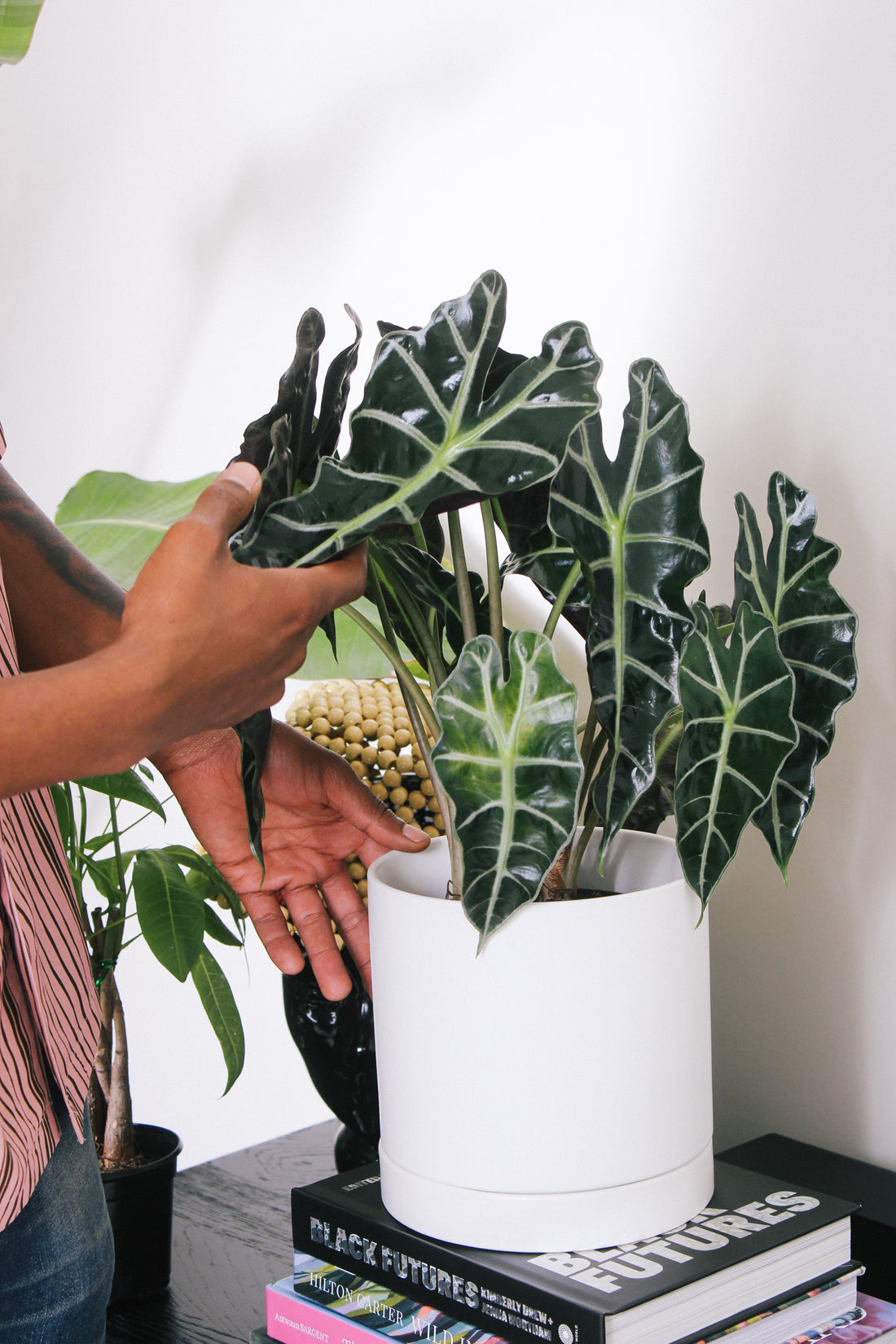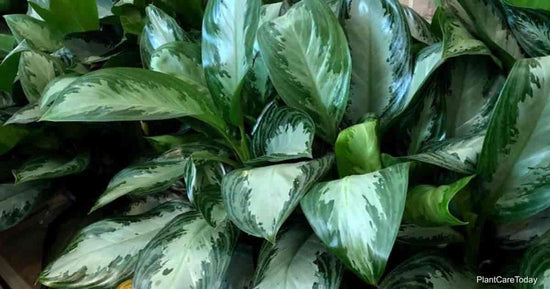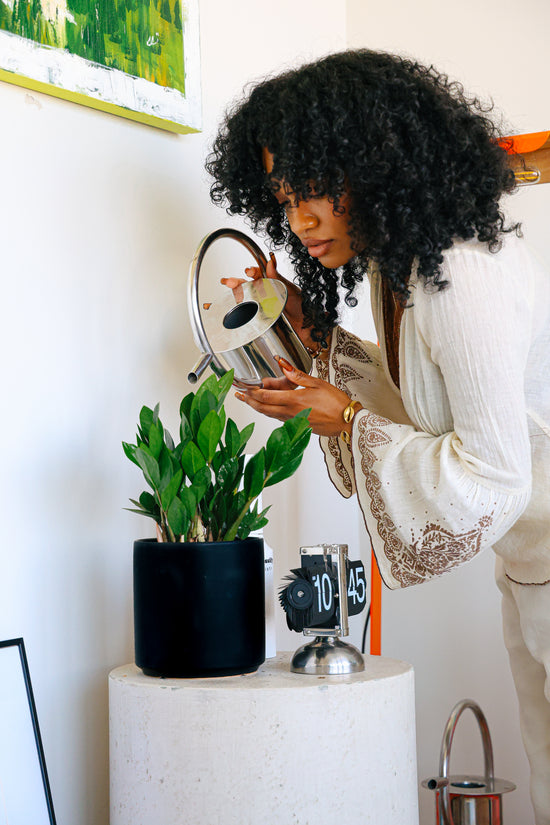Everything you need to know to keep the Polly healthy + thriving
Maintenance: Intermediate | Climate: Warm+Humid | Light: Bright + Indirect | Watering: Consistent | Pet Safe: No
CHARACTERISTICS
Alocasias are native to tropical rainforests of southeast Asia, where they developed their striking glossy leaves. The Polly is a hybrid plant that grows just two feet tall with deep hues and a natural shine. The Polly grows full and dense by quickly producing new growth over its lifetime.
LIGHT
The Alocasia Polly thrives in bright and indirect light. Sunlight filtered through curtains and proximity to a bright window will keep it happy. Choose a sunny room with an east, south, or west-facing window. It can also tolerate medium light levels as well. For the best growth, rotate your Alocasia often and keep it away from direct sunlight.
WATER
Keep soil slightly moist by watering after the soil has dried down at least three inches. The Polly doesn’t mind drying out briefly in between, though this tropical plant should never go through a drought. Leaves will begin to droop under thirst.
We suggest watering generously and using non-tap water. Gradually reduce how often you’re watering through fall and winter.
AIR
Alocasias are happiest and look their best when provided with a tropical environment. In warm temperatures and high humidity, they push out new growth throughout the year and stay in good health. Maintain indoor temperatures between 65º-85º and boost humidity via:
- Misting the leaves 4-6x per week with non-tap water
- Adding a humidifier nearby
- Creating a pebble tray that lives underneath the pot
- Placement in a bathroom or kitchen, if lighting is suitable
Keep your plant in a stable place, free of drafts. Too much change will put unnecessary stress on your Alocasia.
PLACEMENT
Alocasias are said to reach for the skies due to their rapid growth toward the light, representing ambition and resourcefulness. This liveliness brings you daily encouragement to keep going.
Ancient Feng Shui practices suggest that placing your Alocasia at the front and center of your home harnesses this encouraging energy into your career and life path. Be mindful of pairing its meaningful symbolism with its environmental needs to reap its many benefits, including excellent air purification.
POTTING & SOIL
Repot your Polly every growing season for the first two or three years. Once your plant is well-developed, it can spend a couple of years in the same container. If your goal is for it to grow larger, increase the pot size by 2 inches for each repotting.
Ceramic planters are great for maintaining an ideal moisture balance for tropical Alocasias. Planters with drainage holes are best, though an inch of pebbles at the base of the pot will work, too.
Your Polly will need well-draining soil that also holds onto enough moisture for the roots. Enrich the soil by adding perlite, coco coir, and orchid bark to your potting mix. In addition, fertilizing throughout the growing season will create a rich ecosystem for roots to stretch. When provided with nutrients and great care, you’ll find a new baby plant growing in the soil someday.
SEASONAL CARE
Like other houseplants in your collection, the Polly will require a few adjustments when the seasons change. Growing season for plants is spring and summer then they rest through fall and winter. The best way to provide seasonal care is:
- Reduce how often you water during fall and winter when the soil dries slower. Gradually increase as your plant requires once spring returns
- Avoid repotting and fertilizing while the plant rests, as it causes stress and damage
- Provide tropical conditions year-round
- Keep your plant away from air vents, heat sources, and drafts
- Dust the leaves to help the plant photosynthesize all year
PRUNING & PROPAGATION
Alocasias usually grow multiple plant groups in their pot over time. When your plant has matured to this point of development, it can be propagated by division. Alocasias will not grow roots from a cutting and must instead be separated by groups at the roots.
To propagate your Alocasia Polly by division:
- Carefully remove the entire plant from the pot and loosen the soil around the root ball
- Decide which plant grouping(s) you’d like to separate
- Separate sections at the roots using your hands or clean shears
- Place each divided plant into its own planter with soil
- Water and let the plant rest! It may experience some shock
Note: Handle with care and know that roots are strong enough to withstand handling and even some injury!
COMMON ISSUES
Though you shouldn’t experience too many issues when caring for your precious Alocasia Polly, here are some signs to look out for.
DROOPY LEAVES
A drooping Alocasia is common when the plant is thirsty or shedding old leaves. Give it some support through pruning and meeting all its needs. Drooping can also be a stress response to shock or environmental changes.
LEAF DISCOLORATION
As old leaves make way for new growth, they’ll change to yellow or brown until pruned away. Direct light, a water imbalance, and infestation also cause leaf discoloration. Check-in with what your plant might need - pruning, watering, or an insecticide treatment may be in order.
CURLED LEAVES
Leaves that curl inward on an Alocasia are a sign of dry air. Give your plant a boost of humidity by misting regularly. For extra measure, check the leaves and undersides thoroughly for any pests that may be warping the leaves.
YELLOW LEAVES
Yellow leaves on an Alocasia plant result from overwatering, low lighting, or natural aging. Remove any yellow leaves and water only once the top 3 inches have dried. Be sure to fertilize during the growing season to rule out a nutrient deficiency.
BROWN EDGES AND TIPS
Brown edges and leaf tips signal underwatering or low humidity. If brown spots develop elsewhere on the leaf and spread, assess the soil moisture and inspect each leaf for signs of fungus or pests.
PRO TIPS
Now that you you’re well versed in caring for your Alocasia Polly, keep these quick tips in mind:
- Rotate regularly for even growth. Leaves quickly lean toward the direction of light, so turning your plant about 45º biweekly will promote even and balanced growth.
- Prune often to maintain your Polly’s appearance and keep new growth healthy. Without pruning, dead leaves will hang over the pot and continue to utilize the plant’s resources.
-----





